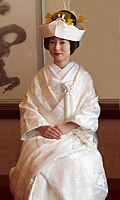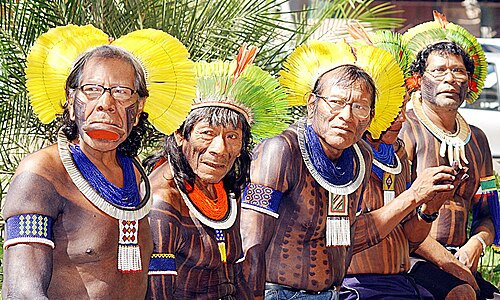AY Honors/Cultural Heritage/Answer Key
1. Outline why it is important to know about our cultural heritage.
For one, knowing about your own culture is interesting. For another, it helps you understand the relationships that exist in your family, whether it be between you and a relative, or between one relative and another.
Learning about your culture is also a way of showing respect and honor to your parents (see Exodus 20:12). It will also give you knowledge that you can pass to your own children and grand children.
Paul understood the importance of understanding culture. "Though I am free and belong to no man, I make myself a slave to everyone, to win as many as possible. 20 To the Jews I became like a Jew, to win the Jews. To those under the law I became like one under the law (though I myself am not under the law), so as to win those under the law. 21 To those not having the law I became like one not having the law (though I am not free from God’s law but am under Christ’s law), so as to win those not having the law. 22 To the weak I became weak, to win the weak. I have become all things to all men so that by all possible means I might save some. 23 I do all this for the sake of the gospel, that I may share in its blessings.” 1 Corinthians 9:19-23
2. List the special ceremonies for:
a. The birth of a child.
Ceremonies for each of these will vary from one culture to another (which, among other things, what makes the various cultures distinct). We list here several ceremonies for marking the events called for in this requirement, but your own culture may very well mark them in other ways. Find out how by asking an older relative.
- Child Dedication
- In many cultures a child is dedicated to the Lord in a ceremony. This shows that the parents are committing themselves to raising the child in accordance to their religious precepts.
- Infant Baptism
- In many cultures, an infant is baptized by having a member of the clergy sprinkle holy water (that is, water that has been blessed in a ceremony) on the baby's forehead. Adventists do not believe this practice follows the Bible.
- Circumcision
- This ceremony, which has its beginnings in the Bible (see Genesis 17:10), is performed on male babies when they are very young (Biblically, when the child is eight days old). It involves the removal of the foreskin from the penis. Some cultures also practice female circumcision.
b. Becoming an adult.
- Quinceañera
- The Quinceañera or Quince Años (sometimes represented XV Años, meaning "fifteen years") is, in some Spanish-speaking regions of the Americas, a young woman's celebration of her fifteenth birthday, which is commemorated in a unique and different way from her other birthdays. In some countries, such as Puerto Rico or Peru, the word Quinceañero is used instead of Quinceañera when referring to the celebration.
- Bar and Bat Mitzvah
- In Judaism, Bar Mitzvah (Hebrew: בר מצוה, "one (m.) to whom the commandments apply"), Bat Mitzvah (בת מצוה, "one (f.) to whom the commandments apply," or Bas Mitzvah in Ashkenazi pronunciation), and B'nai Mitzvah (pl.), are the terms to describe the coming of age of a Jewish boy or girl. According to Jewish law, when Jewish children reach the age of majority (generally thirteen years for boys and twelve for girls) they become responsible for their actions, and "become a Bar or Bat Mitzvah." This also coincides with physical puberty.[1] Prior to this, the child's parents are responsible for the child's adherence to Jewish law and tradition, and after this age, children bear their own responsibility for Jewish ritual law, tradition, and ethics and are privileged to participate in all areas of Jewish community life.
- Prom
- In the United States and Canada a prom, short for promenade, is used to describe a formal dance held at the end of an academic year. Boys usually dress in black tie (a dinner jacket and bow tie), sometimes with brightly colored cummerbunds or vests, though any sort of formal wear can be worn. Traditionally, girls gave boys matching boutonnieres to be worn on their tuxedos or waistcoats. Girls traditionally wear formal gowns or dresses adorned with a corsage given to them by their date.
- Debutante
- A debutante (or deb) (from the French débutante, "female beginner") is a young lady from an aristocratic or upper class family who has reached the age of maturity, and as a new adult, is introduced to society at a formal presentation known as her "debut" or "coming out". Originally, it meant the young woman was eligible for marriage, and part of the purpose was to display her to eligible bachelors and their families with a view to marriage within a select upper class circle. This traditional event varies by region, but is typically referred to as a debutante ball if it is for a group of debutantes. A lone debutante might have her own "coming-out party", or she might have a party with a sister or other close relative.
- Genpuku
- Genpuku, also called Kakan, was a historical Japanese coming-of-age ceremony. To mark the entry to adult life of boys between the ages of 12 and 16, they were taken to the shrines of their patron kami. There they were presented with their first adult clothes, and their boys' hairstyles were changed to the adult style. They were also given new adult names.
- Poy Sang Long
- The Poy Sang Long (Shan: "Festival of the Crystal Sons") is a rite of passage ceremony among the Shan peoples, in Burma (Myanmar) and now in Northern Thailand, undergone by boys at some point between seven and fourteen years of age. It consists of taking novice monastic vows and participating in monastery life for a period of time that can vary from a week to many months or more. Usually, a large group of boys are ordained as novice monks at the same time.
- Russ
- Russ is a tradition and cultural phenomenon in Scandinavia. In Norway, students who graduate from upper secondary school are called russ and celebrate with the characteristic festivities (russefeiring) during the first few weeks of May. In Sweden, a similar celebration is called Studenten ("the student"). In Finland students celebrate the start of the final test in a similar tradition called penkkarit. Also in Denmark graduation from high school (studentereksamen) is celebrated in similar ways as in Norway, including the wearing of caps in different colours and riding in open trucks, while the Danish term rus refers to first-year college students.
- Scarification
- Scarification has been used for many reasons in many different cultures:
- Scarification has been used as a rite of passage in adolescence, or to denote the emotional state of the wearer of the scars, such as times of sorrow or well-being. This is common among Australian Aboriginal and Sepik River tribes in New Guinea, amongst others.
- The Māori of New Zealand used a form of ink rubbing scarification to produce facial tattoos known as "moko." Moko were considered to make the body complete as Māori bodies were considered to be naked without these marks. Moko were unique to each person and served as a sort of signature. Some Māori chiefs even used the pattern of their moko as their signatures on land treaties with Europeans.
- In some cultures, the willingness of a woman to receive scarification shows her maturity and willingness to bear children.
- Scarification is fairly common in West Africa and New Guinea.
- Facial scarring was a popular practice among the Huns.
- Facial scarring resulting from academic fencing is regarded as a badge of honor among the European dueling fraternities, this tradition originating in the 19th century.
c. Death and burial.
A funeral is a ceremony marking a person's death. Funerary customs comprise the complex of beliefs and practices used by a culture to remember the dead, from the funeral itself, to various monuments, prayers, and rituals undertaken in their honor. These customs vary widely between cultures, and between religious affiliations within cultures. Because these practices are so vastly different from one culture to the next, and there are so many ways that death and burial are marked, we will not attempt to cover them here. Instead, you are referred to the Wikipedia article on Funerals. If your own culture's funerary rites are not covered there, you may need to do a little research on your own.
3. a. List the customary ways of dressing for everyday life and two special occasions.
3. b. Draw, explain or present in pictures these customary dresses.
We answer these two questions together.
Everyday Life
Most cultures have at least two types of clothing for "everyday life" - clothing for casual situations (such as lounging around the house), and clothing for more formal situations (such as going to work). Many people have jobs that allow them to wear casual clothing to work, and many others are required to wear a suit and tie or a uniform.
You should already be familiar with the "everyday life" clothing used in your own culture - just look around!
Wedding Clothes
Wedding clothing has a wide variety across the globe, but the traditional western wedding gown and tuxedo has come to enjoy near universal acceptance.
Formal Clothes
In many cultures, people attend church in their best clothing. A suit and tie is common for men, and a formal dress is common for women. In other cultures, fancy traditional garb is worn to church, such as a sari or a kimono.
4. What is or was the customary pre-marriages for young people in your area? How is/was marriage arranged?
This requirement cannot be answered in this book because pre-marriage and marriage customs vary so widely throughout the world. However, it is likely that you are already familiar with the pre-marriage customs in your culture. If you are not, ask an older person, such as a parent, an aunt, or a grandparent.
5. List the advantages of traditional marriages over western style marriages and courtship.
A "traditional marriage", or an arranged marriage is a marriage arranged by someone other than the persons getting married, curtailing or avoiding the process of courtship. Such marriages are not uncommon in the Middle East, parts of Africa, and Asia. Other groups that practice this custom include the Unification Movement, royal families and Hindus.
Note that the term "arranged marriage" is used even if the parents have no direct involvement in selecting the spouse. The match could be selected by a matchmaking agent or trusted third party. In many communities, priests or religious leaders as well as trusted relatives or family friends play a major role in matchmaking.
Advantages of Traditional Marriages
- Effects of Emotion Limited
- Proponents of arranged marriage believe that individuals can be too easily influenced by the effects of love to make a logical choice.
- Reduction or elimination of incompatibilities
- Marital incompatibility has been found to be the major reason for divorce, some Asian writers (especially in India) suggest that arranged marriages might promote a higher probability of success because they tend to match persons with a compatible, but not necessary identical, profile (refer to the factors considered in matchmaking). The parents or matchmaker may draw from the experience of typically at least 20 years of married life to inform their judgment.
- Lower divorce rates
- Many proponents of arranged marriages point to the 0% to 7% percent divorce rate for arranged marriages in contrast with a 55% divorce rate for the United States. Although the numbers differ dramatically, this is an under-researched area and there are many possible explanations for the difference. For example, the divorce rate for love marriages in India is much lower than the divorce rate in the United States although the divorce rate for arranged marriages is even lower. Perhaps the traditional culture of India exerts pressure on couples to stay married, even if the partners selected each other by a process of courtship.
6. a. Explain briefly the meaning of the term “bride price.”
Bride price, also known as bride wealth, is an amount of money or property or wealth paid to the parents of a woman for the right to marry their daughter. (Compare dowry, which is paid to the groom, or used by the bride to help establish the new household, and dower, which is property settled on the bride herself by the groom at the time of marriage.) In the anthropological literature bride price has often been explained in market terms, as payment made in exchange for the bride's family's loss of her labor and fertility within her kin group.
The practice of the bride price is found in the Bible, in the Old Testament. Exodus 22:15-16 says: "If a man seduces a virgin who is not pledged to be married and sleeps with her, he must pay the bride-price, and she shall be his wife. If her father absolutely refuses to give her to him, he must still pay the bride-price for virgins." NIV
Deuteronomy 22:28-29 states similarly: "If a man find a damsel that is a virgin, which is not betrothed, and lay hold on her, and lie with her, and they be found; then the man that lay with her shall give unto the damsel's father fifty shekels of silver, and she shall be his wife; because he hath humbled her, he may not put her away all his days." KJV
b. What are the advantages of bride price.
An advantage of bride price is that it discourages the parents of a young lady from allowing their daughter to marry a man who cannot financially support her and their family. A young man must demonstrate the capacity to raise wealth before he is allowed to marry. This helps to ensure a certain level of maturity on the part of the groom.
c. Explain the disadvantages of bride price.
The obvious disadvantage of bride price is that it places a monetary value on a human being. It may also plant the idea in the groom's mind that since he "paid" for the bride, she is his "property".
7. Explain the leadership structure in your village area. (Include the chiefly system and the extended family.)
A traditional tribal chief is the leader of a tribe, or the head of a tribal form of self-government.
The notion of a "tribal chief" is rather vague and arbitrary; neither chief nor tribe is clearly defined, so in many cases other designations are used for the same institution, such as petty ruler or even headman (in a very small but autonomous community, e.g. in the jungle). In some cases they merely lead a traditional consultative entity within a larger polity, in other cases tribal autonomy comes closer to statehood.
There are many variations on it, but the most common types are the chairman of a council (usually of 'elders') and/or a (broader) popular assembly in 'parliamentary' cultures, the war chief (can be an alternative or additional post in war time), the hereditary chief, the politically dominant medicineman ('theocratic' cultures).
The term is usually distinct from chiefs at still lower levels, such as village headman (geographically defined) or clan chief (an essentially genealogical notion), as the notion 'tribal' rather requires an ethno-cultural identity (racial, linguistic, religious etc.) as well as some political (representative, legislative, executive and/or judicial) expression.
Tribal government around the world
Many minority ethnic groups in many countries have founded semi-autonomous regions in their part of the country such as the Kurds in Iraq. Weak governments in Africa and other areas (Pakistan for example) may have little to no control over far-flung regions with ethnic minorities.
During the 600 BC to 200 BC Period, there were many tribes in India. The Tribal Chief, also known as Raja in those times, lead the tribe and was generally the oldest and wisest in the tribe.
In Gaelic Ireland, up to its destruction in the 16th Century, hundreds of families such as the Cunninghams, O'Neills, MacCarthys and O'Flahertys, organised as clans like tribes, were ruled by tribal chiefs of the name or taoisigh (a title later adopted for the prime minister of the Republic of Ireland), titled according to their surname as The O'Neill, The O'Flaherty etc. This system came to an end at the end of the 16th century.
References
- Wikipedia articles








